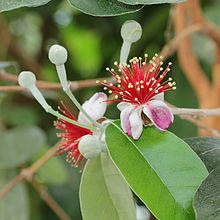
Back فيجوة شائعة Arabic فيجوه شائعه ARZ Acca sellowiana AST Acca sellowiana Azerbaijani کایماک آغاجی AZB Feijoa Catalan Acca sellowiana CEB Fejchoa Czech Brasilianische Guave German Acca sellowiana Esperanto
This article needs additional citations for verification. (October 2015) |
| Feijoa sellowiana | |
|---|---|

| |
| Fruit | |

| |
| Flower | |
| Scientific classification | |
| Kingdom: | Plantae |
| Clade: | Tracheophytes |
| Clade: | Angiosperms |
| Clade: | Eudicots |
| Clade: | Rosids |
| Order: | Myrtales |
| Family: | Myrtaceae |
| Subfamily: | Myrtoideae |
| Tribe: | Myrteae |
| Genus: | Feijoa O.Berg |
| Species: | F. sellowiana
|
| Binomial name | |
| Feijoa sellowiana (O.Berg) O.Berg
| |
| Synonyms[2] | |
|
Acca sellowiana (O.Berg) Burret | |
Feijoa sellowiana[2][3] also known as Acca sellowiana (O.Berg) Burret,[4] is a species of flowering plant in the myrtle family, Myrtaceae. It is native to the highlands of southern Brazil, eastern Paraguay, Uruguay, and northern Argentina.[5] Feijoa are also common in gardens of New Zealand.[6] It is widely cultivated as an ornamental tree and for its fruit. Common names include feijoa (/feɪˈʒoʊ.ə/,[7] /-ˈhoʊ.ə/,[8] or /ˈfiːdʒoʊ.ə/[9]), pineapple guava and guavasteen, although it is not a true guava.[10] It is an evergreen shrub or small tree, 1–7 metres (3.3–23.0 ft) in height.[11]
- ^ IUCN SSC Global Tree Specialist Group, Botanic Gardens Conservation International (BGCI).; Canteiro, C. (2019). "Acca sellowiana". IUCN Red List of Threatened Species. 2019: e.T152946605A152946607. doi:10.2305/IUCN.UK.2019-3.RLTS.T152946605A152946607.en. Retrieved 22 March 2023.
- ^ a b Govaerts R. (2020). "Feijoa; in Plants of the World Online". Kew.
- ^ Lucas, Eve J.; Holst, Bruce; Sobral, Marcos; Mazine, Fiorella F.; Nic Lughadha, Eimear M.; Barnes Proença, Carolyn E.; Ribeiro da Costa, Itayguara; Vasconcelos, Thais N. C. (September 2019). "A New Subtribal Classification of Tribe Myrteae (Myrtaceae)". Systematic Botany. 44 (3). American Society of Plant Taxonomists: 560–569. doi:10.1600/036364419X15620113920608. ISSN 0363-6445. Retrieved 17 November 2022.
- ^ "Acca sellowiana". keys.landcareresearch.co.nz. Retrieved 2023-02-14.
- ^ "Acca sellowiana". Germplasm Resources Information Network. Agricultural Research Service, United States Department of Agriculture. Retrieved 25 May 2013.
- ^ Cite error: The named reference
nzpeoplesfruitwas invoked but never defined (see the help page). - ^ Brazilian Portuguese preferred pronunciation — http://dictionary.reference.com/browse/feijoa feijoa. The American Heritage Dictionary of the English Language: Fourth Edition. 2000
- ^ Spanish preferred pronunciation — Sunset Western Garden Book, 1995:606–607
- ^ "'Citrusy aroma': how feijoas baffled a New Zealand immigrant – and polarise a nation". The Guardian. 2021-04-02. Retrieved 2021-04-04.
pronounced "fey-oa" in its native South America and "fee-jo-ah" in New Zealand
- ^ Morton JF (1987). "Feijoa; In: Fruits of Warm Climates". Center for New Crops & Plant Products, Department of Horticulture and Landscape Architecture, Purdue University, West Lafayette, IN. pp. 367–70.
- ^ "Feijoa | plant species | Britannica". www.britannica.com. Retrieved 2023-02-15.
